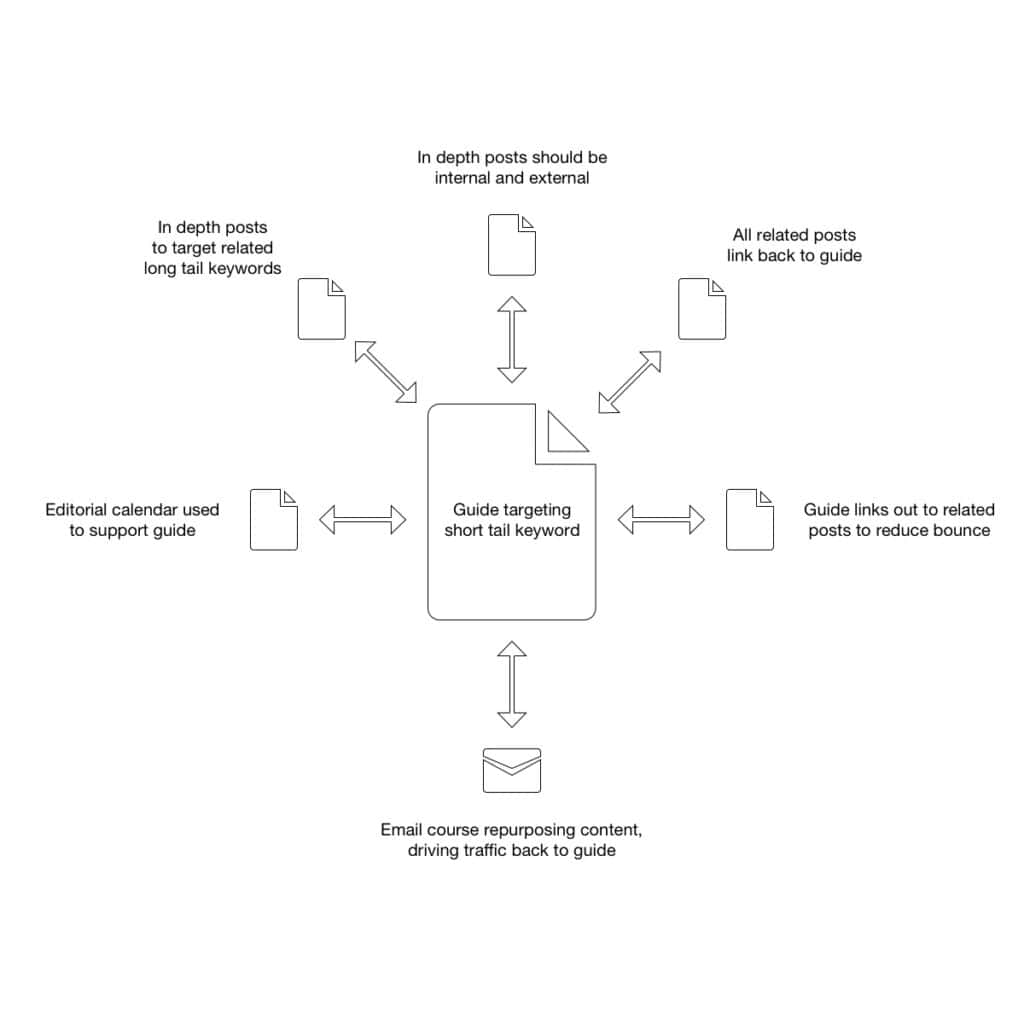AI content isn’t the future, it’s already here. You may be drowning in “expert takes” from SMEs obviously built in ChatGPT, freelancers thinking they’ll sneak something by your AI detection system, or cold emails from one of the thousands of new AI tools being marketed to content folks today. Your LinkedIn feed is definitely AI all the time (except when it’s layoff porn).
You might not be rolling out the welcome mat for our new robot overlords, but it would be foolish not to take advantage of AI. It’s extremely unlikely that Google and other search engines decide that nothing produced with AI is allowed to rank; AI is already being integrated into search. Wise use of AI will also look good on your resume and can legitimately help you do more with less (an imperative all marketing leaders have heard from a CFO at some point).
Play to AI’s Strengths
AI doesn’t build original research, create thought leadership, or even tell the truth. But AI can write. It produces an infinite number of words very fast, and those words have a high quality floor. That is, content made by AI can only be so bad with respect to grammar and usage. It can only be so good in other ways, but not every piece of content needs to change the world. If building 10x content was that easy, content marketers would have surely succeeded at world domination by now.
Build your content strategy to support AI’s strengths instead of asking it to do things that are still in the human realm. That means finding opportunities where you’ve been stuck because you can’t:
- Generate the necessary volume of content
- Rely on consistency from article to article
- Find a way to mitigate risk (“What if we build 100 articles and don’t see traffic/conversion?”)
If we take those potential roadblocks out of the equation, three approaches to content strategy get a whole lot easier.
Bling Out Your Hub With Lots of Spokes
Hub and spoke content is one of the most tried and true options for content marketers. This term gets tossed around a lot, and it often means different things to different people. To be clear, I’m not talking about hub and spoke content where we take one piece of pillar (aka skyscraper) content and repurpose it into infographics, webinars, etc. I’m talking about one significant, major piece of content — either a table of contents or a long-form pillar page — that has many internal links to and from supporting content. These other blogs should drive organic traffic on their own for longtail keywords, but because they are so closely tied to the larger piece of content (or table of contents), they also keep people on your website and drive more traffic to your “main” piece of content. The idea is that your main page for the topic will start ranking for a high-difficulty, shorttail keyword.

This strategy works, full stop. Competitors with poor SEO site architecture, thin content, or who just aren’t paying attention will quickly find you’ve eaten their lunch. AI makes this approach even better.
As an example, let’s say we want to rank for “how to play chess.” This is going to be hard: the information has been around for thousands of years, chess.com has some serious authority in the space, and chess influencers are going wild on Twitch, Youtube, and Tiktok.
Starting with a large-scale hub helps people self-select what kind of chess content they need:
- Skill level (beginners need to understand the rules of the game)
- Game phase (opening vs end game)
- Strategic options (positional vs tactical)
Let’s say we want a blog for each chess opening. AI can give us the basics, but how about embedding a recent game from two well-known pros or influencers? Finding that game in a chess database is a human task that turns these articles into rich content. Instead of spending time crafting an introduction for “Caro-Kann Defense” that isn’t duplicating your intro for “Queen’s Gambit Declined,” you can make your content better.
Here’s where the AI is a game changer: there are more than 1300 documented chess openings. Having humans build an article for every single one would be a disaster. Instead of building just enough spokes to make our strategy work, AI will completely fill our wheel with spokes and make our website as comprehensive as possible.
We can use AI to help build out content at scale beyond what would have been possible before and use our human time to improve the resources. Internal links will generate traffic (for say, “how to play the Caro-Kann defense” or for keywords related to one of the many subvariations of the Najdorf line in the Sicilian Defense) but also keep pointing back to our hub and building authority for our whole website.
Chase Medium-Difficulty Keywords
Medium-difficulty keywords are often ignored when we build a content strategy. Investing resources in ranking for high-difficulty keywords that will really move the needle and drive business results makes sense. Investing fewer resources in longtail keywords that exactly match the search intent of a potential customer makes even more sense. Investing medium resources to maybe rank for something that isn’t bottom of funnel or likely to drive huge traffic volume? Not a smart bet.
With cyborg content we can invest very few resources in these medium-difficulty keywords. We can make a few bets without spending time and effort, or we can invest more resources and cover a wide range of medium difficulty keywords. If even a couple work out, we end up creating an entirely new stream of traffic that competitors are likely ignoring.
You can also test different approaches against each other. Perhaps for one medium-difficulty keyword, you create several pieces of content. For another, you build some original research to support your efforts. You can analyze which techniques are most effective for this strategy and refine your approach for the next round.
Use a “Bet” Strategy
Attacking medium-difficulty keywords with cyborg content works because it takes what was previously a risky bet (medium or large resource investment in something that may or may not work) and makes it easier (low resource investment into something that might work). Bet strategies work the same way.
In a bet strategy, (a technique I learned from Mark Rogers) you use Google Trends and audience research to identify keywords that are powerful for your business but have low search volume today and potentially high search volume later. This might be a travel business with keywords around a solar eclipse (or another infrequent event). Today, no one needs to travel to see the eclipse. That cluster of keywords has no value. But we all know that eventually it will, and if your website is entrenched on page one for those keywords, you’ll reap the rewards when search volume increases. You can even go back and refresh or update the content to make sure you get every scrap of traffic when the time comes, but for now, you get to rank for a relatively easy keyword. Enjoy the blue ocean!
Not all bets are this straightforward. Other bets might be tangentially related to your business or far less likely to have increased search volume in the future. Building content for those is a larger risk, even though the keywords currently have little volume and are probably easy to rank for today. You won’t spend much effort on this content, but every piece of effort you do spend might be wasted if search volume never increases.
Cyborg content empowers you to make many of these bets because you can create content for more of them with less effort. You aren’t producing thought leadership here, you’re targeting relatively simple keywords with low difficulty. Your content is meeting a minimum quality bar but isn’t reshaping an industry or driving demand with potent thought leadership. This use case is tailor-made for AI.
Bonus Round: More AI Content Strategy
Content strategy isn’t just about choosing keywords and building blogs. Using AI creatively opens up other opportunities for content teams. You can look at what AI does poorly for inspiration or spend the time you save with AI tools (whether for keyword research, beating writer’s block, or generating content) to prioritize other content initiatives.
Outflank ChatGPT
What is your target audience asking ChatGPT to do? Go ask ChatGPT the same thing. Find the places where the robot falls short (it often gives surface-level, boring, top of funnel drivel with no opinion or insight). Write the content that answers your target audience’s follow-up question. It might not rank right away, but it’s damn helpful content that reminds your ICP they need you.
Clear Your Backlog
Every content lead I’ve ever spoken with has top of funnel ideas that got deprioritized, changed, or otherwise cast aside and are living in a forgotten Asana task or Notion template. Go do those things. You brainstormed them for a reason. You can either do them faster with the help of AI or you can use AI to clear your plate of other stuff (like adding spoke content) and use the time to build these instead.
Build Stuff AI Can’t Build
There’s a time and a place for AI — but the internet is already full of garbage content, and it’s only going to get worse as more and more people copy/paste AI onto their websites. Build better stuff than that. Some of the best content before ChatGPT is still the best content because it automatically includes human connections, true authority, and original research:
- “State of” reports with real survey data
- Podcasts
- Quotes from SMEs
- Case studies with real data from real success stories
- Templates real humans can use to make their lives easier
Strategy Is More Important Than Ever
AI’s effect on content marketing isn’t written into the history books, but we should start taking advantage of the opportunities now. And for now, AI can’t build a full-funnel content strategy. It can’t interview customers, access real data for keyword research, or prioritize your work. Figure out how to implement it in your content strategy so that you can make smarter decisions and prioritize work that only humans can do.



